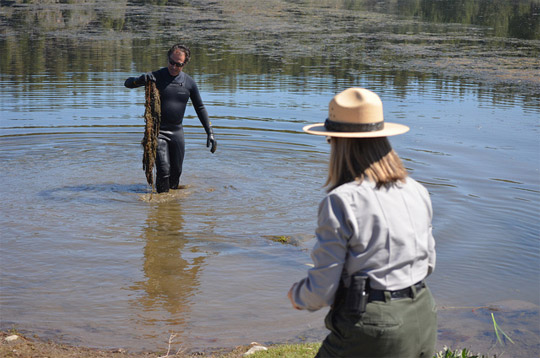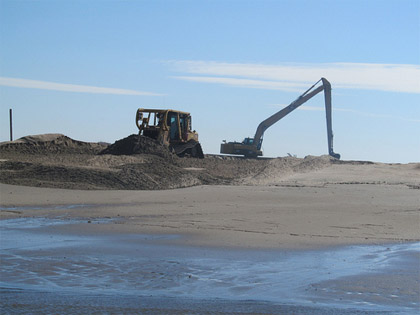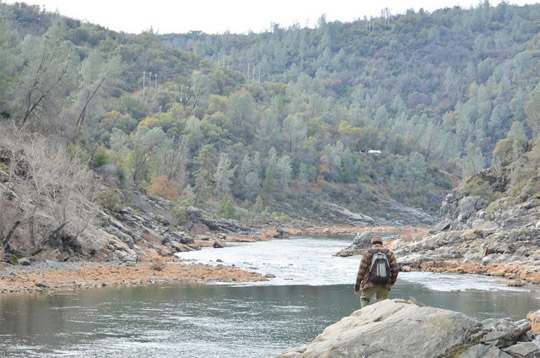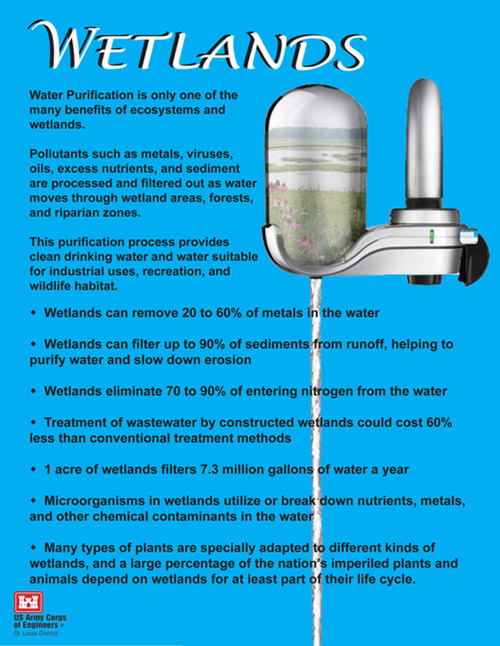U.S. Army Corps of Engineers Environmental Operating Principles II
Preamble. The U.S. Army Corps of Engineers’ (USACE) Environmental Operating Principles (EOP) were developed to ensure Corps missions include totally integrated, sound environmental practices. The Principles provided corporate direction to ensure the workforce recognized the Corps’ role in, and responsibility for, sustainable use, stewardship and restoration of natural resources across the Nation and also through the international reach of its support missions. Since EOP were introduced in 2002, they have instilled environmental stewardship across business practices – from recycling and reduced energy use at Corps and customer facilities to a fuller consideration of the environmental impacts of its actions and meaningful collaboration within the larger environmental community.
The concepts embedded in the original Principles remain vital to the success of the Corps and its missions. However, as the Nation’s water resource challenges and priorities have evolved, USACE has responded by close examination and refinement of work processes and operating practices. This self-examination includes how USACE considers environmental issues in all aspects of corporate enterprise. In particular, strong emphasis on sustainability must be translated into everyday actions that have an effect on the environmental conditions of today as well as the uncertainties and risks of the future. These challenges are complex and range from global trends like increasing and competing demands for water and energy, climate and sea level change and declining biodiversity to localized manifestations of these issues in extreme weather events, spread of invasive species and demographic shifts. Accordingly, USACE is reinvigorating its commitment to EOP in light of this changing context.
Environmental Operating Principles relate to the human environment and apply to all aspects of business and operations, crossing Military Programs, Civil Works and Research and Development. EOP requires a recognition and acceptance of individual responsibility – from senior leaders to the newest team members. Recommitting to these principles and environmental stewardship will lead to more efficient and effective solutions, and will enable the Corps to further leverage resources through collaboration. This is essential for successful, integrated water resources management, restoration of the environment and sustainable and energy efficient approaches to all USACE mission areas. It is also an essential component of the Corps’ risk management in decision-making, thus allowing the organization to counter uncertainty by building flexibility into the management and construction of its human and business assets. The re-energized Environmental Operating Principles are:
- Foster a culture of sustainability throughout the organization;
- Proactively consider environmental consequences of all USACE activities, and act accordingly;
- Create mutually supporting economic and environmental solutions;
- Continue to meet corporate responsibility and accountability under the law for activities undertaken by the Corps, which may impact human and natural environments;
- Consider the environment in employing a risk management and systems approach throughout life cycles of projects and programs;
- Leverage scientific, economic and social knowledge to understand the environmental context and effects of USACE actions in a collaborative manner; and
- Employ an open, transparent process that respects views of individuals and groups interested in Corps activities.
The following explanations of each Principle are provided to synchronize communications on EOP and to suggest ways to evaluate effectiveness of these Principles in guiding USACE practices. The latter may be tailored to better mesh with specific work programs across the Corps’ diverse mission areas.

U.S. Army Corps of Engineers photo by John Prettyman | Tahoe Divers Conservancy director, Phil Caterino, pulls invasive milfoil from Martis Creek Lake, Truckee, Calif., during a weed barrier removal, cleaning and replacement project May 19, 2012.
Environmental Operating Principles II: Explanations
(Throughout these Principles, the word “environment” shall mean the holistic environment, including both natural and human needs as these Principles guide Corps of Engineers’ efforts to foster and to promote the general welfare, to create and to maintain ecological and physical conditions under which man and nature can exist in productive harmony, and to fulfill social, economic and other requirements of present and future generations of Americans.)
1. Foster a culture of sustainability throughout the organization. The Corps must continue to achieve a culture of sustainability, which entails the concept of stewardship, wise management and responsible use of natural resources. It requires that biological systems remain diverse and productive, that the Corps reduce energy consumption and water usage, and that it promotes reuse and recycling in construction and operations. Sustainability must be incorporated into all USACE activities to the extent feasible. It has ecological, economic and social dimensions. Protecting and restoring natural systems and the environment while encouraging productive, sustainable economic development, which improves quality of life, is the Corps’ triple bottom line. And, it applies to all missions and administrative functions.
Promoting sustainability needs to be both a corporate and an individual goal. Its concepts need to be integrated at all organizational levels from senior leaders to the newest team members. The Corps needs to identify more sustainable solutions in its planning processes and decision documents. When needed, training in sustainable practices may be required, whether it be for commanders and senior leaders or team members, and should be incorporated into existing courses. This is not a requirement for development of new training courses but a requirement that all existing courses include appropriate information on consideration and implementation of EOP.
2. Proactively consider environmental consequences of all Corps activities and act accordingly. All USACE entities will exert leadership on environmental issues relevant to projects and programs, and engage others early and often. All actions undertaken by the Corps will be considered in their full context and incorporate lessons learned from similar actions in order to ensure USACE activities avoid adverse environmental consequences and implement appropriate mitigation where avoidance is not practicable. Decision-making will continually account for changing environmental conditions or context.
Planning and programming without compromising the environment must be timely, concise and cost-effective. Decision documents will clearly show how effects of a candidate action have been considered. Recommendations minimizing negative effects or enhancing positive ones should be supported.
3. Create mutually supporting economic and environmental solutions. Corps employees will endeavor daily to develop options for action that not only achieve their stated mission goal but also protect the environment and quality of life. Humans benefit from the range of vital products and processes provided by healthy ecosystems and environments. These products, ranging from food and habitat to purification and recreation nourishment, are commonly termed “ecosystem services,” which need to be evaluated as environmental benefits or costs in USACE decisions. Protecting and restoring natural systems and the environment while encouraging productive, sustainable economic development to improve quality of life is the Corps’ triple bottom line.

U.S. Army Corps of Engineers photo by Melissa Alvar | Freshly pumped sand is moved around by heavy equipment on Yellow Bar Hassock Marsh Island March 1, 2012, at a USACE-led ecosystem restoration project in Jamaica Bay in Queens, N.Y.
The Corps has major roles as stewards of the Nation’s aquatic resources and in balancing all decisions to protect those resources. It also has a mission to restore properties and ecosystems, thus making both available to the public for beneficial use. This Principle takes the goal of achieving environmental sustainability in all USACE missions a step further by pointing the way towards procedures that will achieve balance between human activities and sustaining natural ecosystems.
Decisions that affect natural systems or processes either as benefits or costs should be accounted for in appropriate monetary and non-monetary metrics. The Corps must employ green engineering design, appropriately sized for the application and considered for the entire life cycle of the project, thus minimizing waste and maximizing energy efficiency. USACE success is highlighted when it avoids environmental conflicts and develops multipurpose projects with ancillary benefits.
With these enhanced models of reality, the Corps can improve its understanding of the ways projects and activities can achieve traditional services, such as flood control, navigation and military activities, in an environmentally sustainable manner.
4. Continue to meet USACE corporate responsibility and accountability under the law for activities undertaken by the Corps, which may impact human and natural environments. Successful projects require effective, comprehensive planning using the full breadth of the vertical/horizontal team. All Corps entities must identify potential environmental concerns when projects/programs are at the conceptual stage and throughout their operational life by engaging counsel and subject matter experts within the organization. In order to avoid delays, an assessment of compliance with environmental requirements must be conducted as early in the process as practicable. Engagement with interagency teams will better anticipate problems and promote collaboration. Coordination with partners and stakeholders is encouraged as early as feasibly possible.
Legal challenges on environmental issues must be monitored and lessons learned incorporated into future actions. Employment of all available tools is required to avoid environmental conflict. Results of their application are to be documented and shared throughout the enterprise.
5. Consider the environment in employing a risk management and systems approach throughout life cycles of projects and programs. Use of conceptual models is fundamental to identifying all sources of risk. Analysis should focus on areas of risk most relevant to the problem at hand. Risk reduction should not be accomplished by designing for overcapacity or overdesign. Design of risk reduction measures should consider areas of relevant risk and utilize adaptive management as appropriate through the life cycle process. Risk assessments need to address both human and environmental health. Unpredictability of natural and manmade events dictate the Corps avoid unwise use of floodplains and vulnerable coastal areas within a systems context. When considering projects, areas with high ecological value and high frequency flood loss should be a focus for restoration or natural area management.
Communicating risk to the public for all projects undertaken is a skill the Corps must master and at which it must excel. USACE must explicitly describe risks and honestly report concerns.

U.S. Army Corps of Engineers photo by Chris Gray-Garcia | Bobby Gonzalez, a field assistant at the University of California-Davis, photographs the Yuba River canyon below Englebright Dam near Smartsville, Calif., Jan. 6, 2012. Researchers will use the images to create a virtual 3D model of the river canyon.
6. Leverage scientific, economic and social knowledge to understand the environmental context and effects of Corps actions in a collaborative manner. The Corps’ experienced workforce and laboratories capabilities position it to be a learning organization, thus embracing new and innovative ideas from both within the organization and from other agencies to understand the environmental context and complexity of its actions. The best available science, practices, analyses and tools will be utilized, and this will require outreach by the centers of expertise to elsewhere in government and the private sector. The Corps will reach inward to prioritize within the Research and Development Program and other areas to identify and to fill gaps in the knowledge base and toolkit.
The Corps will implement and refine the timely, concise and cost-effective planning initiative of the Civil Works program and comparable initiatives in other mission areas. This will require gauging the level of analysis to be conducted commensurate with the scope of the decision. These efforts will require effective training, including collaborative training with other agencies, cross-training teams to facilitate use of datasets developed by other agencies as well as increased accessibility to cross-training programs within vertical and horizontal teams. Utilizing uniform data standards will both serve to assist and to measure the leveraging of scientific, economic and social knowledge bases.
7. Employ an open, transparent process that respects views of individuals and groups interested in and affected by Corps activities. Today, USACE is called by the Nation to deal with complex problems characterized by competing economic and environmental factors and stakeholders with diverse opinions as to how to resolve those competing demands. The Corps will consider ethnic, cultural and economic values and factors as it designs its projects and considers alternatives affecting the human as well as natural habitat.
The Corps will, to the maximum extent practicable, make maximum effective use of transparency in scoping and planning actions, which will help to elicit new insights from individuals and diverse stakeholder groups. This will ensure all USACE decisions on resource management give appropriate consideration to all interested individuals, groups and businesses. This principle recognizes and emphasizes that all individuals and groups, as members of the public, are partners with the Corps. Encouraging dialogue will yield diversity of opinions, which can provide fertile grounds for innovation.
USACE will make proactive use of innovative public involvement techniques to enhance stakeholder participation and to gather the required public comments in response to public notices. The Corps will use current and developing technology, including web and social-based media. It will actively learn from customer surveys, restoration advisory boards, industry examples and by engaging stakeholders in public sessions.Issue





























